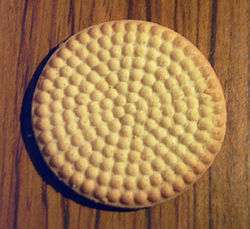Lincoln biscuit
 | |
| Alternative names | Lincoln Creams |
|---|---|
| Type | Biscuit |
| Place of origin | United Kingdom |
The Lincoln is a short dough biscuit, a member of the genus, shortcake biscuits. It has a pattern of dots on the top in concentric circles. The McVitie's version had the word 'Lincoln' embossed on to the biscuit at the centre. Recently it has been very difficult to obtain,[1] but recipe books still champion and enhance the basic recipe.
For many years they were known as Lincoln Creams and no one ever seemed to ever question the fact there was no cream or indeed that they do not hail from Lincoln. Lincoln biscuits are still available in Irish supermarkets and dedicated fans can still order a packet at several sites dedicated to providing hard-to get essentials for British expats. Despite losing popularity in recent years, the basic recipe has come under academic scrutiny[2][3] and commercial analysis. In 2004 Campden and Chorleywood Food Research Association set up a research project to
"understand the textural properties which influence consumer acceptance of short dough biscuits (e.g. Lincoln type): ingredient functionality will enable the hardness, crunchiness and breakdown properties to be varied and their acceptability measured." 08.02.04/365
In Argentina, Kraft Foods produces Galletitas Lincoln, rectangular Lincoln biscuits with the familiar dot pattern, under the Terrabusi brand name. They are ubiquitous.
Bibliography
- Baker, J.S.; Boobier, W.J.; Davies, B. Development of a healthy biscuit: an alternative approach to biscuit manufacture Nutrition Journal March 2006, 5:7 doi:10.1186/1475-2891-5-7[4]
- Fearn T.; Miller A.R.; Thacker D.: Rotary moulded short dough biscuits Part 3: The effects of flour characteristics and recipe water level on the properties of Lincoln biscuits. Flour Milling and Baking Research Association Report (FMBRA) 1983, 102:8-12.
- Lawson R.; Miller A.R.; Thacker D.: Rotary moulded short dough biscuits: Part 2. The effects of the level of ingredients on the properties of Lincoln biscuits. Flour Milling and Baking Research Association Report (FMBRA) 1981, 93:15-20.
- Miller A.R.; Thacker D.; Turrell S.G.: Performance of single wheat flours in a small-scale baking test for semi-sweet biscuits. Flour Milling and Baking Research Association Report (FMBRA) 1986, 123:17-24.
- Lawson R.; Miller A.R.; Thacker D.: Rotary moulded short-dough biscuits Part 4. The effects of rotary moulder control settings on the properties of Lincoln biscuits. Flour Milling and Baking Research Association Report (FMBRA) 1983, 106:9-17.
References
- ↑ Sunday Telegraph Issue 2,391 8 April 2007 Letters to the Editor p24
- ↑ Baker, J.S.;Boobier, W.J.; Davies, B. Development of a healthy biscuit: an alternative approach to biscuit manufacture Nutrition Journal March 2006 doi:10.1186/1475-2891-5-7
- ↑ Lawson, R.; Miller, A.R.; Thacker D.: Rotary moulded short dough biscuits: Part 2. The effects of the level of ingredients on the properties of Lincoln biscuits. Flour Milling and Baking Research Association Report (FMBRA) 1981, 93:15-20.
- ↑ Boobier, W. J.; Baker, J. S.; Davies, B. (15 March 2006). "Development of a healthy biscuit: an alternative approach to biscuit manufacture". Nutrition Journal. 5 (1): 7. doi:10.1186/1475-2891-5-7 – via www.nutritionj.com.